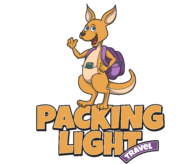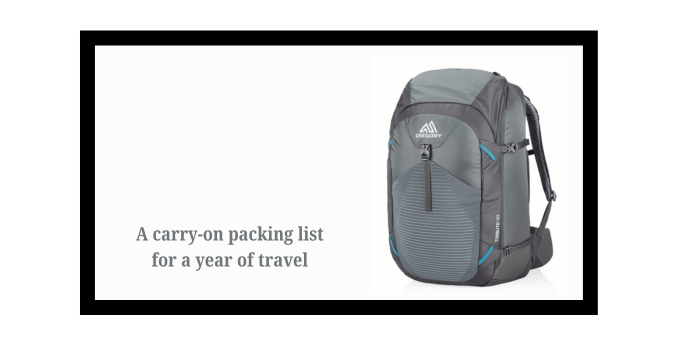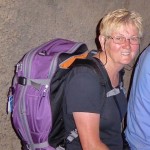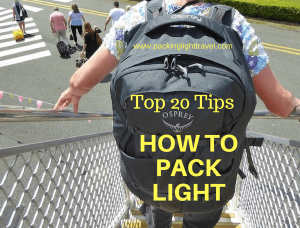How does a person, or in this case, two people, create a detailed carry-on packing list for long-term travel? Derek and Jackie planned a year-long trip across multiple climatic zones; naturally, as carry-on travellers, packing was critical to their preparation.
Along the way, they constantly analyzed what worked and what didn’t, and what changes needed to be made to what, and how they packed. Decisions were made about what to discard, what to mail home, what to donate, and what to retain or remove from their packing list.
Here is their story, with a detailed packing list for a year of carry-on travel.
Table of Contents
A trip in two parts
Jackie and Derek are from Eastern Ontario in Canada. Jackie is a photographer who specializes in family and wedding photography. Derek is a teacher who took advantage of a deferred salary benefit by deferring 20% of his salary for four years to finance a year of leave to travel in the fifth. In other words, 80% of his salary was spread over five years, including the year of travel.
Trip dates mirrored the Canadian school year, typically from September to June inclusive. The first part was from July to December (2022) and the second from January to August (2023). In between, the couple returned to Canada for a short Christmas break. As it related to packing, this enabled them to reassess their previous packing decisions and readjust what needed to be discarded, replaced, or added for the next phase of the journey (to South America and Antarctica).
Anchoring the 13-month trip were several key adventures booked many months in advance. As the trip unfolded, they were prepared to make the necessary adjustments to plans that were more tentative in nature.
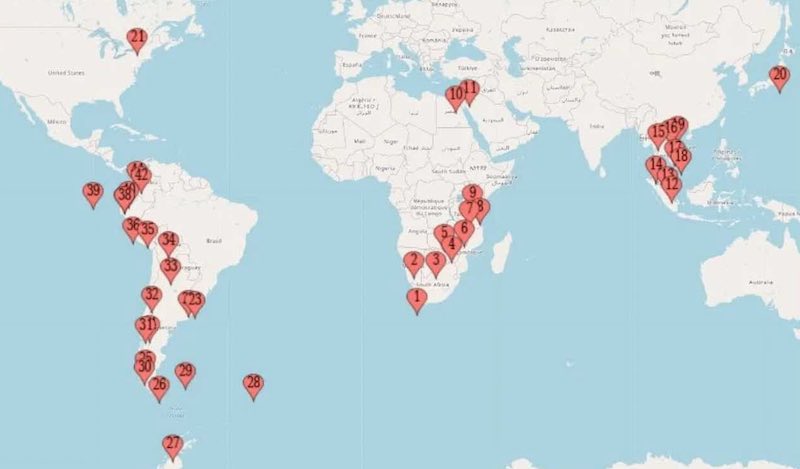
(i) First part
From July to December, the itinerary included flights to Cape Town and a 49-day overland camping trip with Intrepid Tours from Cape Town to Nairobi. Those segments were followed by independent travel to Egypt, Jordan, Singapore, Malaysia, Thailand, Cambodia, Vietnam, and Japan.
(ii) Second part
From January to August, the second leg involved travel to Argentina, Antarctica, Chile, Bolivia, Peru, Ecuador, and Colombia.
Key packing considerations
1. List making
Jackie is a consummate researcher, planner, and packer who generated shopping and packing lists many months before the trip. While satisfied with most purchases, many were untested, hence some trepidation regarding packing choices and the need for constant analysis and adaptation.
2. Carry-on travel
Both were committed to packing light and never checking bags. This involved packing only what they could carry, being mindful that a long trip isn’t an excuse to overpack, and choosing multi-use and multipurpose items. Shoes were limited to two pairs, and enough clothing packed for a week without laundering. This meant travelling with a limited number of pieces of carefully selected clothing in lightweight, quick-drying fabrics.
3. Use of ‘freebies’
Using and collecting freebies was also considered. Many accommodation providers stock guest toiletries, and business-class amenity kits include ear plugs, sleep masks, and toiletries. Their Antarctica cruise company supplied 3-in-1 parkas, which were factored into their packing choices for the nine-day hike in Torres del Paine National Park in Chilean Patagonia.
4. The ‘buying-it-there’ practice in moderation
While the pair aimed to leave Canada with everything they needed, they were open to making purchases when circumstances warranted. This came sooner than expected when cooler temperatures in South Africa necessitated picking up a warmer layer. Around the same time, they discovered that sleeping bags were needed for the overland trip with Intrepid. Sleeping bags and fleece sweaters were found for a reasonable price in Cape Town; the sweaters saw a ton of use at night throughout Africa, and the sleeping bags were donated to a grateful recipient in Kenya. Despite the oversight, they would have chosen to pick up the sleeping bags in South Africa to avoid checking luggage on the first set of flights.
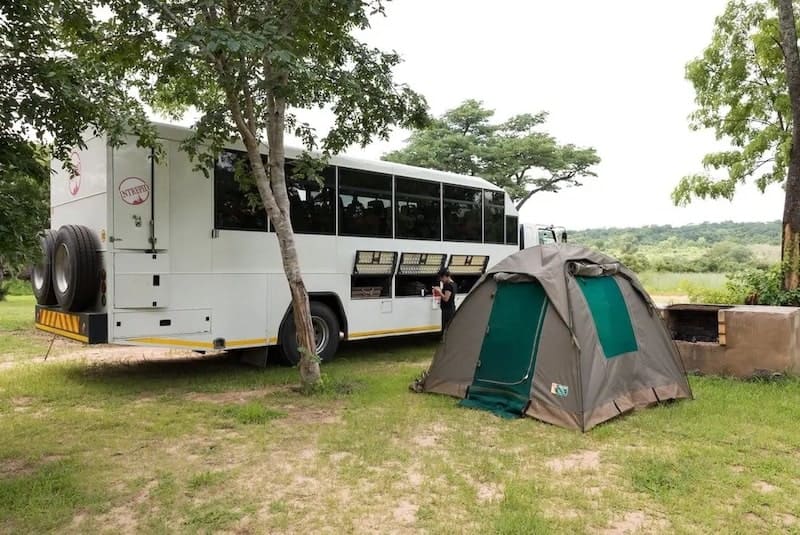 Photo credit: Intrepid
Photo credit: Intrepid
5. Balance between quality and price
Another consideration was to resist being seduced by expensive travel products. Where feasible, brand names such as ExOfficio and Icebreaker were avoided in favour of cheaper, lightweight, quick-drying clothing.
6. Dollar stores were investigated as sources of useful travel gear
Why spend valuable travel dollars on travel gear when dollar stores offer cheaper alternatives? They’re not only a source of lower-cost options, but they offer creative solutions to making strategic use of what’s on dollar-store shelves.
Along the same lines, the pair used their creative energies to make inexpensive, packable travel gear. Derek created a small, custom-made travel cribbage board using a laser cutter and pieces of paper clips for playing pegs. Jackie utilized her sewing skills to make breathable, waterproof pouches for soap and shampoo bars with PUL (Polyurethane Laminate) remnants purchased on Etsy.
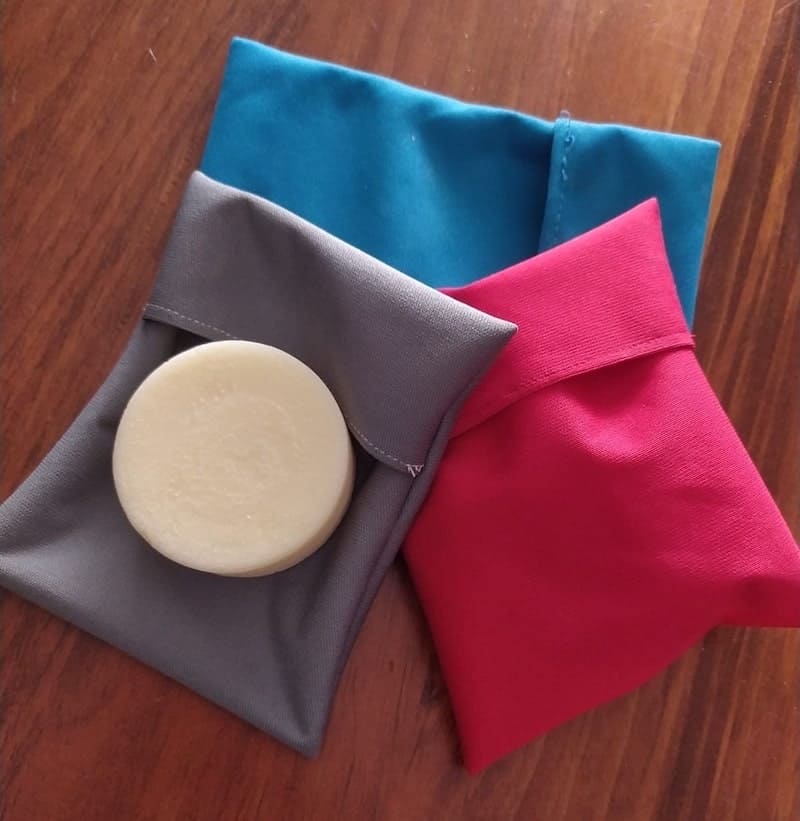
7. Protection from mosquitoes
Mosquitoes! They’re the world’s deadliest creatures, killing 725,000 humans each year. How does one prepare for protection from malaria, dengue fever, and other mosquito-borne diseases? Avoiding insect bites was a prime consideration, so stickers, high-DEET repellent, and permethrin-treated clothing had prominent places on their packing list.
8. Money matters
Avoiding and minimizing bank fees and the ability to efficiently access cash to pay for purchases were other critical considerations. This involved carrying several credit cards, taking into consideration which ones earned points multipliers and waived foreign transaction fees. It also meant keeping travel accounts topped up for ATMs that don’t allow a choice between savings and chequing accounts and choosing the best credit card points earners to link to accounts such as Uber.
9. Travelling on points
Derek and Jackie are avid collectors of travel points. This lets them significantly offset travel costs with valuable frequent flyer and other travel points. Many of their flight redemptions were in business class, and various reward programs covered other miscellaneous travel expenses.
The flip side of redeeming points for travel is to capitalize on travel expenses to meet minimum spending requirements to unlock sign-up bonuses on new credit cards. It also involves the strategic use of credit cards to maximize points-earning opportunities. These factors influenced how trip expenses were utilized to amass more points to reduce costs. Also, travelling in business class influenced packing decisions.
10. Function over fashion
Some of the trip involved physically challenging outdoor activities. These included camping in Africa, cycling beside the Mekong River, hiking in Chile, kayaking in the Galapagos Islands, horseback riding in Columbia, and sandboarding in Peru. Therefore, choosing clothing and shoes that offered protection and comfort while withstanding the rigours of travel was paramount.
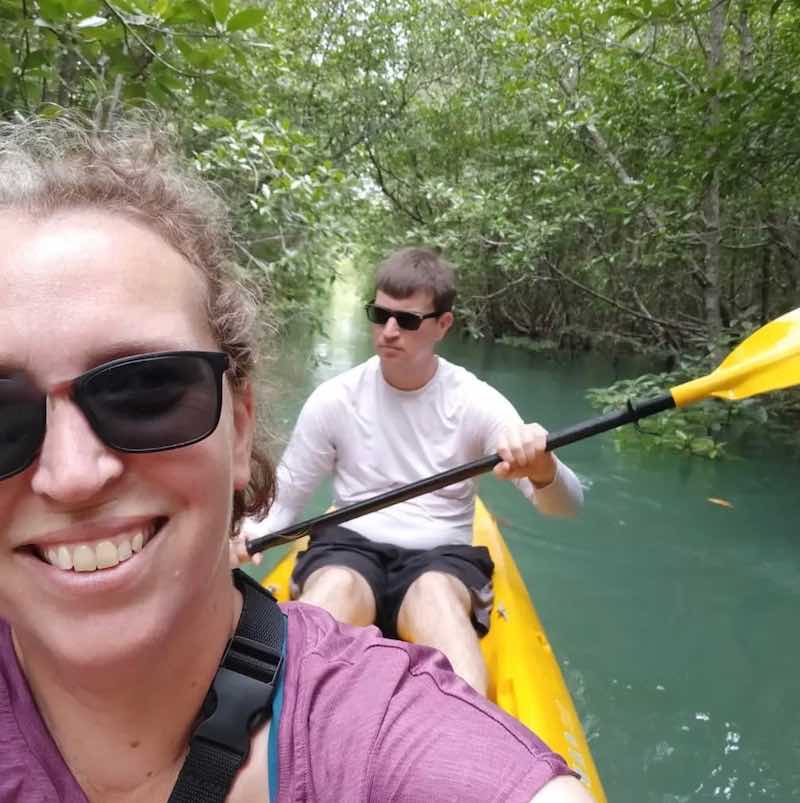 Koh Yao Yai, Thailand
Koh Yao Yai, Thailand
Detailed carry-on packing list for long-term travel
The following packing list breaks down what each person packed and includes an assessment of what worked and what didn’t. Notes refer to what could have been left behind, what had to be purchased, which items failed to live up to the rigours of travel, which ones met expectations, and various recommendations for other travellers.
DOCUMENTATION and FINANCES
- Passports
- International Driving Permit
- Visas (printed)
- Vaccine printed proof (on water-resistant photo paper): printed proof was required a couple of times.
- Pre-paid card: IBKR (Interactive Brokers)
- Credit cards: Scotiabank Passport Visa Infinite (2), HSBC World Elite MasterCard (2). A backup credit card was hidden in one of the carry-on backpacks.
- Debit cards: Canadian bank cards (2) for use in countries where the IBKR isn’t accepted.
- Currency: Some USD banknotes were hidden for use as emergency cash. Otherwise, ATMs were a source of cash. One exception was for Argentina, the first country on the South American part of the trip when new USD 100 banknotes were packed from Canada.
LUGGAGE and RELATED ITEMS
- Osprey Ozone Duplex 65
- Osprey Ultralight Rain Cover Large
- Osprey Ultralight Stuff Pack
- Gregory Tribute 40L Travel Pack
- Rain Cover
- Lowepro Passport Sling DSLR Camera Bag
- Crossbody Dry Bag (HEETA Waterproof Pouch)
- Money belt (Stashbandz Running Belt)
- Foldable travel duffel bag (Wandf)
- Packable shopping bag
Derek chose the Osprey Ozone Duplex 65, a carry-on backpack with a detachable duffel. With a combined volume of 65 litres, the backpack is around 22 litres, while the duffel is larger at 43 litres. With the Ozone Duplex, only one of the bags has shoulder straps that are quite wide. Many carry-on bags have a smaller detachable backpack, around 15 litres, but Derek finds these straps too narrow.
The Osprey Ozone Duplex 65 appears to be discontinued. As with most luggage with a detachable bag, both pieces can’t be packed to capacity to attach them. Overall, Derek was happy with his choice; if you can find it, he recommends the bag to other travellers.
Derek packed an Osprey Ultralight Rain Cover Large that fits 50 to 75-litre packs and an Osprey Ultralight Stuff Pack, a small 20-litre packable backpack.
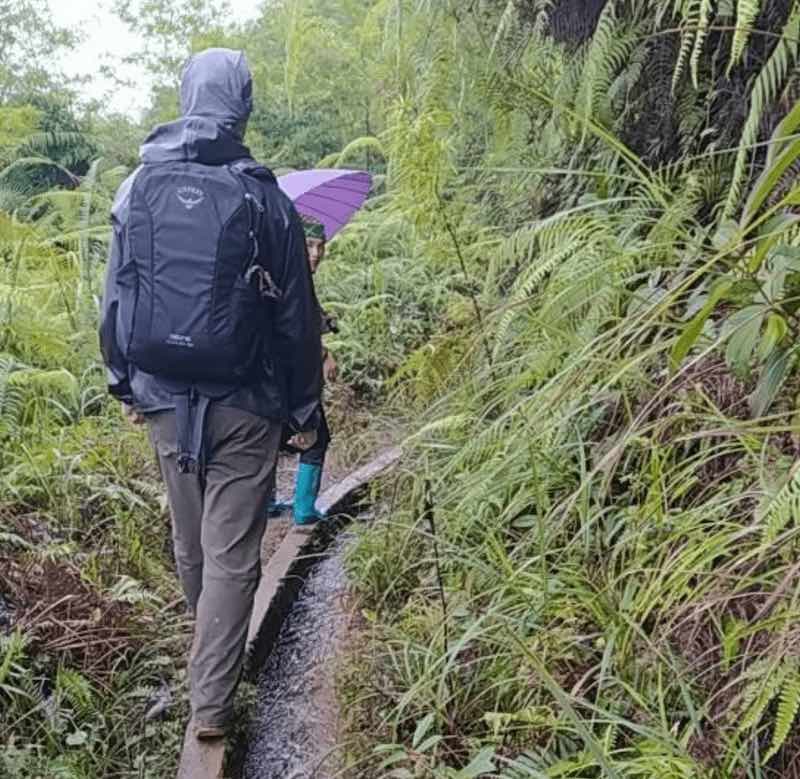 Trekking in Sapa, Vietnam
Trekking in Sapa, Vietnam
Jackie tried various bags at an outdoor store and found the best fit with the Gregory Tribute 40L Travel Pack, preferring it to the 40-litre Osprey options. This was complemented with a rain cover.
The importance of visiting an outdoor store to test various bags cannot be overstated. Walk around with each bag packed to the weight you expect to carry before choosing. Another suggestion for women is to try the backpacks with their bra choices. One of Jackie’s rubbed uncomfortably while wearing the pack. A shortcoming of the Gregory Tribute is the lack of internal compression straps. Still, Jackie is pleased with her choice.
Jackie chose the Lowepro Passport Sling DSLR Camera Bag to carry daily essentials and camera equipment for a combined purse, day bag, in-flight personal item, and camera bag.
Crossbody dry bag (HEETA Waterproof Pouch): The versatility of a crossbody waterproof bag meant it came in very handy on multiple occasions. Highly recommended.
Money belt (Stashbandz Unisex Running Belt): This was functional and comfortable, especially when wearing leggings or pants without pockets.
Foldable travel duffel bag (Wandf): The duffel was added for Part 2 of the trip to South America, which included a nine-day hike in Patagonia. Backpacks were carried on the hike, and gear not required was left behind in the duffel.
PACKING AIDS
Derek
- One large and two medium packing cubes (eBags)
- Dry bag (IKEA): This was handy, especially for stowing clean clothes and toiletries in campsite showers. However, it needed to be replaced for South America.
- Electronics Bag
- Laundry Bag
- Hanging Toiletries Kit (Travelon Wet/Dry One-quart Bag)
- Waterproof PUL fabric case (Etsy)
Jackie
- Medium (3) packing cubes (eBags)
- Homemade waterproof PUL fabric soft cases made from PUL remnants (Etsy)
- Toiletries kit (Travelon Wet/Dry One-quart Bag)
- Laundry Bag
CLOTHING, SHOES, and ACCESSORIES
Derek and Jackie expected mosquitoes to be a major problem in many countries and were amazed by how few mosquitoes were spotted. They have more at their summer home in Ontario! So, the stickers, high-DEET repellent, and permethrin-treated clothing were unnecessary but worthy of keeping on a packing list for a bug-infested trip.
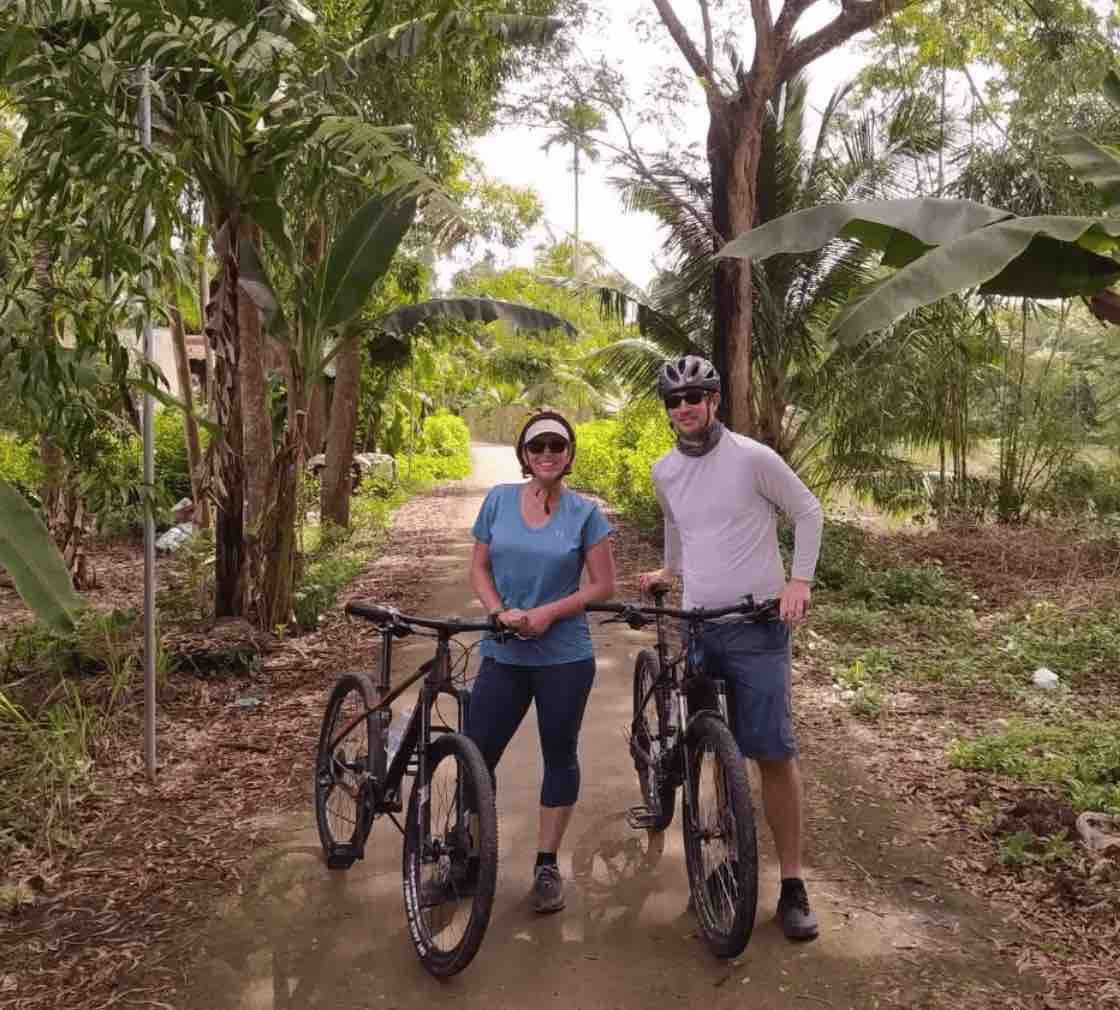 Cycling Mekong River, Vietnam
Cycling Mekong River, Vietnam
Derek
- Rain jacket (Columbia OutDry Extreme HikeLite Shell Jacket)
- Socks (7) + Compression socks (1)
- Underwear (8)
- T-shirts (5) + Golf Shirt (1)
- Long-sleeved T-shirts (2), one Permethrin-treated (Craghoppers)
- Hiking pants (3), one Permethrin-treated (Craghoppers)
- Swim trunks (1)
- Hiking shorts, quick-drying (3) (Eastern Mountain Sports Men’s Compass 4-Points)
- Buff
- Trail runners (Salomon Trail Running Shoes): These lost their tread quickly and were discarded after five months of wear.
- Sneakers to double as water shoes (
 ): These performed well on several hikes but not in sandy environments. The tongue and laces stayed wet for a long time.
): These performed well on several hikes but not in sandy environments. The tongue and laces stayed wet for a long time. - Cooling Towel (Dollarama): wasn’t used, so it wasn’t repacked for South America.
- Ball cap, permethrin-treated (Wind River, Mark’s Work Wearhouse): This was in a light colour and became very dirty early in the trip. The permethrin was unnecessary, barely used, and wasn’t packed for South America.
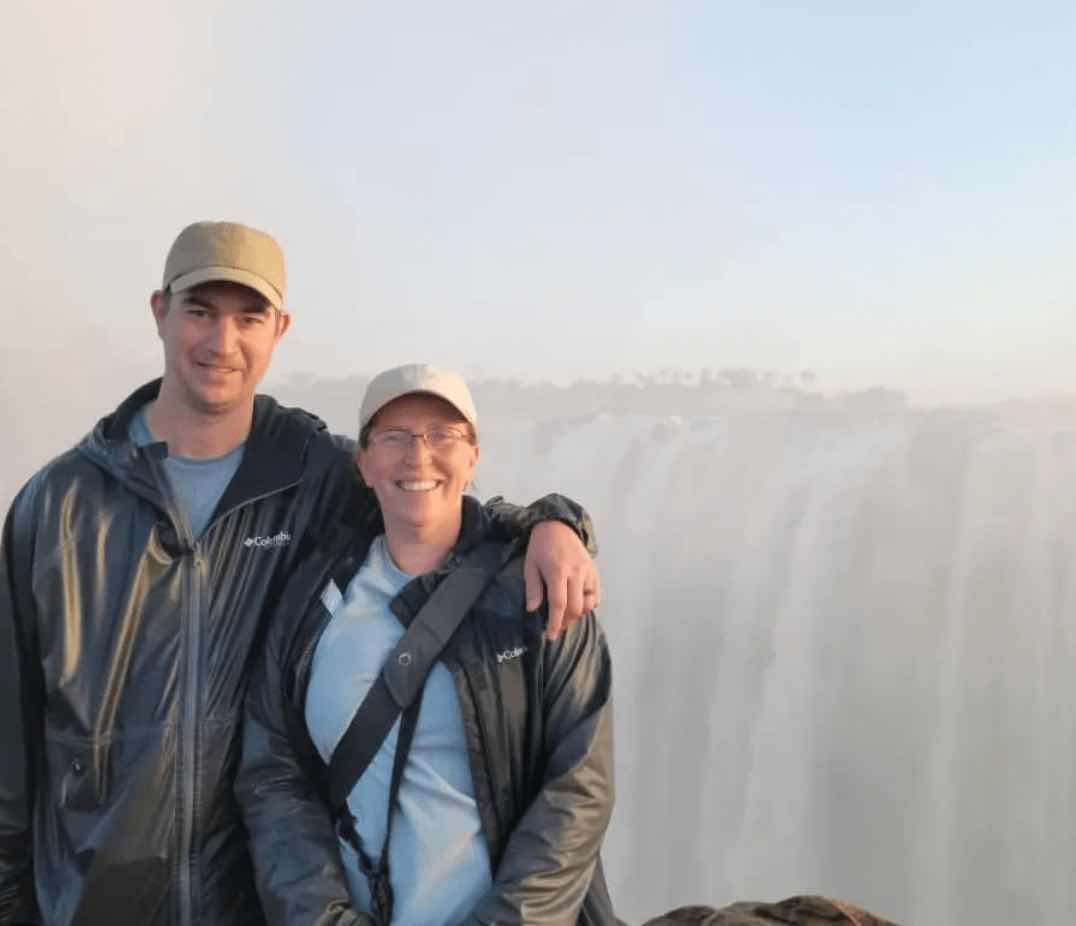 Victoria Falls, Zimbabwe
Victoria Falls, Zimbabwe
Jackie
- Trail runners: These wore through the toe box and were replaced with Nike Waterproof Women’s React Pegasus Trail 4 Gore-TEX.
- Teva Sandals: The model is discontinued. If replacing them, Jackie would buy a pair of Teva Ascona Sport Webs or Teva Tirra Fi Lites. Either choice doubles as water shoes and works for dressier wear.
- Rain jacket (Columbia OutDry Extreme HikeLite Shell Jacket)
- Sports bras (Old Navy) (2) + regular bra (1): As mentioned, make sure a backpack is compatible with bra choices. Sports bras that don’t have removable cup liners are easier to wash. Jackie purchased another sports bra in Bangkok.
- Permethrin-treated scarf: It wasn’t necessary as an anti-mosquito head covering, and the permethrin wasn’t helpful. It wasn’t used, so not packed for South America. However, some type of head covering, such as a scarf or wrap, is necessary for many countries.
- Buff
- Cooling towel (Dollarama): not used and was not repacked for South America.
- Ball cap, permethrin-treated (Wind River, Mark’s Work Wearhouse): This was in a light colour and became very dirty early in the trip. The permethrin was unnecessary; it was barely used, and not packed for South America.
- Bathing Suit
- Socks (5) + compression socks (1): Another pair of socks was purchased in Bangkok as Jackie wore closed-toe shoes more often and sandals less than predicted.
- Anti-chafing shorts (Jockey Slipshorts): These weren’t repacked in favour of a Body Glide Anti-Chafe Stick instead.
- Underwear (8)
- T-shirts (5) + long-sleeved (1): All underwear and T-shirts were in fast-drying athletic fabrics.
- Dressy short-sleeved shirt (1): This was mailed home.
- Short-sleeved, knee-length dress
- Cover Up (Craghoppers Insect Shield Kaftan): Not used/not repacked for South America
- Loose wide-leg pants: These were explicitly packed for mosque and temple visits but were unsuitable when using squat toilets. They were mailed home.
- Hiking pants (Columbia)
- Shorts
- Capri leggings
- Full-length leggings (Craghoppers Insect Shield Luna Leggings): They’re decent leggings, but the permethrin was unnecessary. Jackie packed a pair with multiple pockets for South America instead.
- Base-layer fleecy leggings: These didn’t wear well but were repacked for colder temperatures in South America and discarded in warmer temperatures.
- Hoodie (AIRism Mesh UV Protection Full-Zip Hoodie): very lightweight, great for sun protection and a modesty cover-up in hot weather. Jackie highly recommends it. It wasn’t packed for South America, but only because a warmer sweater was chosen.
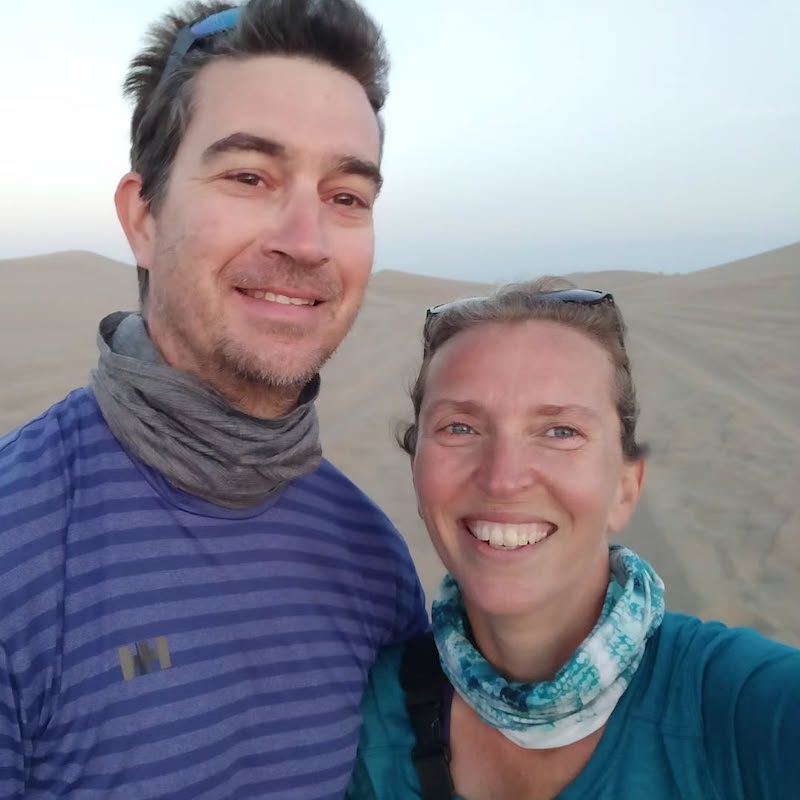 Sand boarding and dune bugging in Huacachina, Peru (with indispensable Buffs).
Sand boarding and dune bugging in Huacachina, Peru (with indispensable Buffs).
TOILETRIES and COSMETICS
Derek
- Toothpaste
- Toothbrush
- Floss
- Body wash (Dr Bronner’s Liquid Soap, 100 ml)
- Bar soap
- Deodorant: Buying acceptable deodorant was difficult in Asia, so two were packed for South America.
Jackie
- Toothpaste
- Toothbrush
- Moisturizer
- Lip balm
- Bar soap
- Solid shampoo and conditioner (Notice Hair Co.): Notice Hair Co. was formerly known as Unwrapped Life. These products worked beautifully. They lasted six months, interspersed with using hotel hair products depending on what was available. Fresh bars were packed for South America.
- Nail clippers
- Anti-chafe stick (Body Glide Original Anti-Chafe Balm)
- Razor (2)
- Comb
- Deodorant
- Menstrual cup (INTIMINA Lily Cup)
FIRST AID and HEALTH AIDS
Derek
- Masks
- Solid sunscreen (2): Solid bars are highly recommended. They’re easy to carry (aren’t considered liquids) and easy to apply.
- Insect repellent (lotion and spray): not used/not repacked for South America
Jackie
- Masks
- DEET-free insect repellent with Picaridin (Pi Active): This was repacked with the plan to purchase something stronger in Colombia if necessary. This Picaridin spray seemed to work well.
- Mosquito repellent stickers (BuzzPatch Natural Mosquito Repellent): not used/not repacked for South America
- Sunscreen, liquid
- Malarone: taken for parts of Africa but didn’t restart doses anywhere in Asia when very few mosquitos were spotted.
- Prescription medication for UTI (Monurol) and Travellers’ Diarrhea
- Various OTC medication and first-aid supplies: An Altoids tin was a compact and convenient way to carry various OTC medication and first aid supplies, including Imodium, Benadryl, Claritin, Tylenol, Advil, Aleve, Robax, Cough Drops, Tums, Band-Aids, Moleskin, safety pins, and a SIM card removal tool.
- Hand sanitizer wipes, tissues
- Hand soap sheets (Travelon)
GADGETS and TECH
Derek
- Headlamp
- Over-ear Noise Cancelling Headphones (Sony): These were replaced with earbuds for South America (Soundcore Life A2 NC, same as Jackie’s)
- Laptop and charger (Dell)
- Mini travel mouse: not used/not repacked for South America
- Travel power strip with adapters (Ceptics): Highly recommended. It’s less compact than some options, but the power bar is handy for two people.
- Battery charger for AA for headlamps and AAA for mouse (IKEA): not used/not repacked for South America
- External hard drive (SanDisk): Tragically, this died. SanDisk customer service replaced it at no charge. Still, the experience confirmed the importance of having multiple backup options. Thankfully, the external hard drive wasn’t the only place Jackie stored her photos.
- USB razor and charging cable
- e-reader (Amazon Fire HD 8 tablet)
- Wired in-ear headphones: These were old and packed for plane travel since they plug directly into the aircraft’s in-flight entertainment system. They weren’t used and were not repacked for South America.
- Fitbit and charging cable (Fitbit Charge 4)
- Charging cube with 2 USB-A ports
Jackie
- Headlamp
- In-ear wireless noise-cancelling headphones (Soundcore by Anker Life A2 NC)
- Power bank (2): These were in constant use. Jackie highly recommends always travelling with a portable power source to charge devices. It’s worth noting most airlines allow passengers to bring power banks in their carry-on luggage but not in checked baggage due to the risk of fire caused by lithium-ion batteries. Size also matters; to be safe, carry 10,000 mAh units as the maximum size. Jackie and Derek observed larger units being confiscated at several airports.
- Camera (Sony RX10 III)
- Camera strap (OP/TECH USA Utility Strap)
- Memory cards
- Replacement battery charger set (JYJZPB NP-FW50)
MISCELLANEOUS
Derek
- Ear plugs: extras weren’t needed; a single set plus the ones from the business-class amenity kits would have been enough.
- Notebook and pencils
- Travel Towel
- Collapsible water bottle (Vapur Eclipse 1 L / 33 oz)
- Sunglasses
- Cribbage Board (custom-made by Derek)
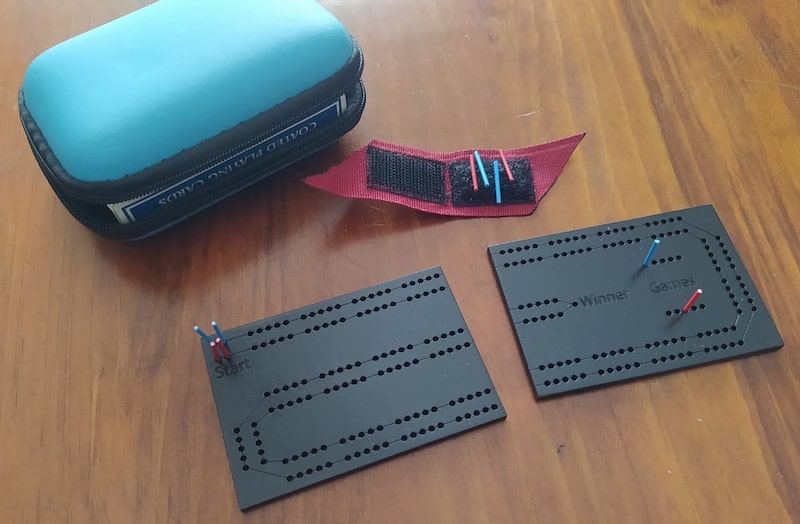
Jackie
- Travel towel
- Collapsible water bottle (Vapur Eclipse 1 L / 33 oz)
- Water purifier bottle (GRAYL Geopress 24 oz)
- Ear plugs
- MacGyver kit: The ‘fix-it kit’ mainstays were a few feet of duct tape wrapped around a thin piece of cardboard, a sewing kit collected from a hotel early in the trip, and a few tubes of the mini super glue from Dollarama.
- Solid laundry soap (Usolve Laundry Detergent Strips): works well in a machine but isn’t user-friendly for handwashing. For South America, Jackie added a bar of Sunlight Laundry Bar Soap and a universal sink stopper (V-TOP Tub Stopper)
- Travel clothesline
- Tablet towels (WYSI)
- Carabiner and metal ties (Wisdompro Wire Keychain)
- Sunglasses
- Notebook and pens
- Sporks (2)
Packing list adjustments for South America and Antarctica
In addition to the changes made to the original packing list as noted above, Derek and Jackie streamlined their clothing needs for the second part of the journey.
- Both pairs of trail runners were worn out and needed to be replaced.
- Long johns were repacked, and toques (wollen hats) and gloves were added.
- Rain pants joined the list. The ones from Eddie Bauer (Cloud Cap Stretch Rain Pants) are attractive without a plastic look and feel. They have adjustable waists to permit wearing over other layers. In a pinch, they could be worn on a laundry day. The men’s version has better pockets, so Jackie suggests that women try on the men’s pants before buying the women’s version.
- Derek’s clothing inventory comprised T-shirts (5), long-sleeved T-shirts (2), a sweater, hiking pants (3), shorts (1), and long johns mentioned above. Swim trunks didn’t make it to the list and would be purchased if necessary.
- Jackie’s streamlined wardrobe comprised T-shirts (5), long-sleeved T-shirts (2), a sweater, capri leggings (1), fleece leggings (1), hiking pants (1), and a dress.
- Both packed underwear (7) and socks (7), including a few pairs of warmer socks and waterproof socks for Antarctica and Patagonia. Waterproof socks are amazing! Their unisex, waterproof, breathable Randy Sun hiking socks are bulky but indispensable on hiking trips. It was a treat to put them on each morning before lacing up shoes that were still wet from the day before. Everyone Jackie and Derek met on their nine-day Patagonia hike was very jealous of their dry feet.
- The sand and saltwater destroyed Derek’s original sunglasses, so they were replaced with fully polarized Shady Rays for Antarctica.

Conclusion
Thank you Derek and Jackie for sharing what you packed (and learned about packing) for long-term travel for the benefit of other travellers.
If you’re embarking on several months of travel to multiple destinations and climates, hopefully Jackie and Derek’s packing lists and accompanying analysis offer the kind of inspiration you need to decide what will earn a place in your travel bags.
If you found this post helpful, please share it by selecting one or more social media buttons. If you have packed for long-term travel, what additional insights can you add? Please share your thoughts in the comments. Thank you.
Pin it for later?
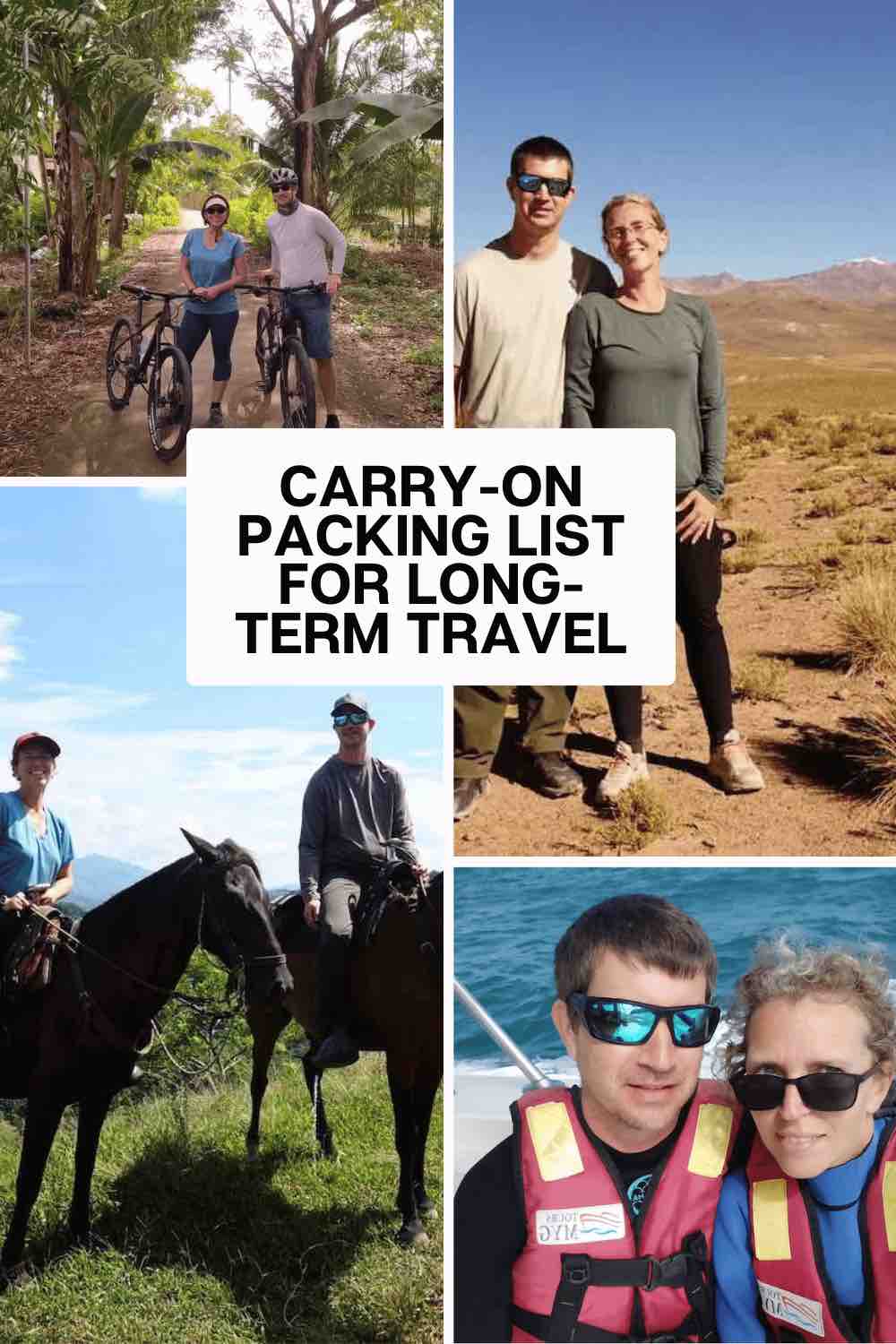
Some of the links on this page are affiliate links. If you use them to buy something, you don’t pay more, but Packing Light Travel earns a small commission which helps pay the costs of maintaining the site. So, thank you for your support.
